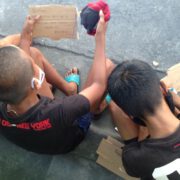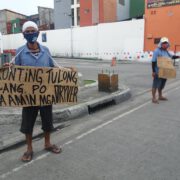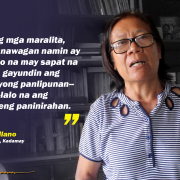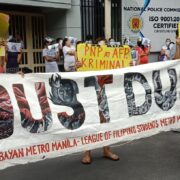President’s SONA in denial of slowing growth and fundamental economic crisis
by IBON Media
In his fourth State of the Nation Address (SONA), President Duterte did not admit that the economy is on a slowdown and that the country’s production sectors are deteriorating. Instead, the President harped on deceptive, business-biased policy proposals that at the very least do not address the basic problems of the economy, and at worse, may aggravate economic woes. Government should build policies upon an honest recognition of the country’s real situation.
Slackening economy ignored
Nowhere in the President’s SONA was it mentioned that the country’s economy has been slowing from 7.1% growth of gross domestic product (GDP) in the third quarter of 2016 to 5.6% in the first quarter of 2019. Growth fell rapidly even after a momentary increase to 7.2% in the third quarter of 2017. This slowdown was happening long before the 2019 national budget impasse and the election ban on infrastructure spending and despite record levels of foreign investment reaching US$9.8 billion in 2018.
It would have been important for the President to note this and admit that the slowdown is due to reliance on unsustainable, external sources of growth: Slowing overseas remittances (average growth rate fell from 15.5% annually in 2002-2008 to 3.7% in 2017-2018) and a slowing business process outsourcing (BPO) sector (average growth rate fell from 43% annually in 2005-2009 to only 2.7% in 2017-2018) that impacted on real estate, renting, and business activities. Household spending, export of services (including BPOs), capital formation (including construction), and government spending also slackened.
This points to the urgency of developing sustainable long-term drivers of growth pertaining to more vibrant agriculture, dynamic Filipino industry, and equitable distribution of economic gains. In his SONA, however, the President, though acknowledging the need to boost agriculture and jobs, stuck to the same type of market-oriented measures that perpetrate underdevelopment and backwardness.
Hampering agriculture
Pres. Duterte vowed to continue investing in agriculture programs to increase the income and productivity of small farmers and fisherfolk. In particular, he said that government will ensure the full implementation of the Rice Tariffication Law’s Rice Competitiveness Enhancement Fund (RCEF) to safeguard the livelihood of small farmers.
But the RCEF amount of Php10 billion annually for six years, which government claims will fund farm inputs and operations, is dismally low compared to Vietnam and Thailand agriculture subsidies. Hugely the funds will be used to purchase commercial equipment, seeds, and services for distribution to local government units and certified farmers organizations. RCEF is prone to patronage politics and might marginalize rather than benefit farmers. Peasant groups also fear that the removal of restrictions on rice importation will displace over 2 million rice farmers and imperil the local rice industry with the influx of imported rice.
By sourcing the Philippine staple from a volatile world market and allowing unlimited albeit tariffied rice importation, rice tariffication threatens farmers’ livelihoods and the country’s food security. It does not address the current state of shrinking agriculture. The sector lost over a million jobs from 2016-2018, and barely grew at 0.8% in 2018 and in the first quarter of 2019. Its 8.2% share of GDP in the first quarter of 2019 is its smallest ever share of the economy, yet 2019 budget allocation to agriculture was reduced by Php3.4 billion from an already low Php50.7 billion in 2018 to just Php47.3 billion in 2019.
Instead of pushing rice liberalization, which will benefit rice importers and private traders more than local rice farmers and rice-eating Filipinos, the government should preserve its mandate to procure a minimum of 25% of local produce to sell at a reasonable price that will influence market rice prices to be affordable. There should also be a genuinely distributive and free land reform program to liberate farmers from having to amortize awarded land, and substantial agriculture support and subsidies from domestic industries that will truly aid in raising productivity and incomes instead of burdening the sector with conditional support and mounting debts.
Stifling Filipino industries
The President also did not address a manufacturing sector that appears to be stalling. Manufacturing growth was just 4.9% in 2018 – the slowest since 2012 – and slowed further to 4.6% in the first quarter of 2019. The sector remains shallow and mostly disconnected from the local economy due to being foreign-dominated and capital-intensive in export enclaves. As a result, employment generation has been relatively weak. Manufacturing employment increased by just 221,000 or 6.5% between 2016 and 2018, with even a contraction of 101,000 reported in April 2019, according to official labor force data.
Instead, he praised the Tax Reform for Acceleration and Inclusion (TRAIN) for helping fund government programs, and pressed for the enactment of the Tax Reform for Attracting Higher and Better Opportunities (TRABAHO) to energize micro, small and medium enterprises (MSME’s) and generate more than a million jobs.
But TRABAHO is a misnomer because its focus is not on creating the stable jobs that Filipinos need, but on lowering corporate taxes and rationalizing incentives. It in fact adds to the regressiveness of TRAIN, which relieves the rich of personal, estate and donor taxes, by increasing corporate profits and the wealth, income, and property of the rich. On the other hand, government will make up for the resulting losses in tax revenues through indirect levies which tax consumption – including by mostly low-wage workers and low-income Filipino families – regardless of their lack of wealth, income and property.
The President’s recommending TRABAHO for MSMEs in his speech diverts from MSMEs’ being mostly in the service sector wherein jobs are usually temporary and low-paying: the top five MSME industries are wholesale and retail trade, repair of motor vehicles and motorcycles, accommodation and food service activities, manufacturing, service activities, and financial and insurance activities. The manufacturing sector would potentially be a generator of stable jobs, however contractualization is rampant. The transnational corporations-dominated sector has even seen Filipino workers suffer poor working conditions and stifled labor rights.
Not only do Filipinos need more jobs, the people need quality jobs. But behind the hype of improved employment are signs of a persistent jobs crisis that no corporate-biased policy intends to cure: over 11 million of the combined unemployed and underemployed, and almost 28 million of the employed being in informal, non-regular, or agency-hired work.

Reorient the economy
Filipino firms must instead be built, sourcing materials from a robust agriculture, and building across consumer, light to heavy industries that will supply the people’s and the nation’s needs. This removes the need to rely on – or be limited to – commercial sources. This will also certainly improve production, stimulate job generation, increase working Filipinos’ incomes, and enliven economic activity both in the rural and urban areas.
All these mean that the government should thwart its business bias so that the country’s economic direction can be refocused to truly prioritize the people’s well-being and national development. This has not been the course of the Duterte administration as evidenced by the neoliberal policies highlighted in his SONA such as rice tariffication and TRABAHO. #







